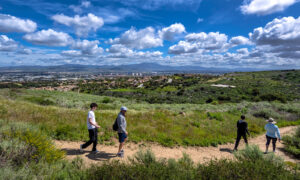In one of the healthiest benefits of living in this master-planned city, more than 9 of every 10 Irvine residents live within a 10-minute walk of a park. That convenience is just one of the reasons that Trust for Public Land recently ranked Irvine’s park system as California’s best, and the fourth-best in the nation.
Trust for Public Land’s senior vice president, Howard Frumkin, the former dean of the University of Washington School of Public Health, took time with us to elaborate on what that means for residents’ physical and mental well-being.
Why did Irvine rank No. 1 in California in your 2023 ParkScore?
Irvine scored high for total acreage of parks and for access to them. The city’s more than 300 parks are well-distributed in the community, meaning that even if you don’t have time to get the physical activity opportunities you get in large parks, you still get the contact with nature and social benefits. At the same time, Irvine has so many hiking and biking trails throughout the city, which connect with open space, so that’s a big plus.
Irvine also generously funds its parks. It got the highest possible score for park investments, with a total of $284 per capita spent on parks and their maintenance. That’s three times the national average. This kind of spending keeps parks well maintained.
Nationally, Irvine ranks just behind Washington, D.C., Minneapolis and St. Paul. What do all of these cities have in common?
All of those cities have plenty of park acreage and fund their parks generously. What’s interesting is that D.C., Minneapolis and St. Paul are all older cities that developed before the automobile era. Among younger, Sun Belt cities, Irvine really stands out for the thoughtfulness with which parks and trails were built into the city design.
Irvine was master planned with the health benefits of parks in mind. Do you know of any other cities that can make that same claim?
Irvine is the only city I’m aware of that was master planned with consideration of the benefits of physical activity in parks and nonmotorized mobility – biking and hiking – as part of the city’s design.
“Irvine is the only city I’m aware of that was master planned with consideration of the benefits of physical activity in parks and nonmotorized mobility – biking and hiking – as part of the city’s design.” – Howard Frumkin
What is the best evidence for the ways that parks improve public health?
Parks are one of the main venues for people to have contact with nature – an important health benefit. They’re also venues for outdoor physical activity, which has many benefits, including reducing the risk of cardiovascular disease, many cancers, osteoporosis and depression. They deliver these benefits in a widely available way, without adverse side effects and at minimal cost.
Parks are also great places for people to meet and mingle, either with family and friends or people we don’t know as well. Being socially connected is really good for health. At a time when we have a lot of schisms in our society, parks offer opportunities for different people to get familiar with each other, which is good for our civic health.
Not least, parks also promote climate resilience, cooling neighborhoods and managing stormwater.









